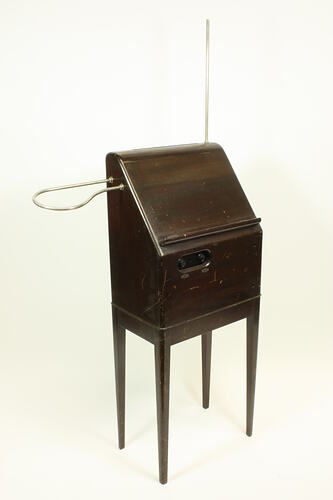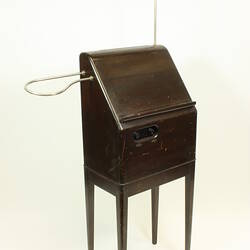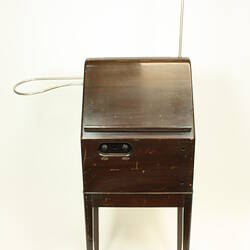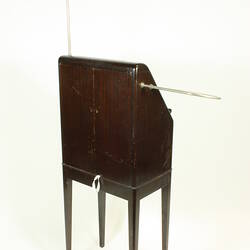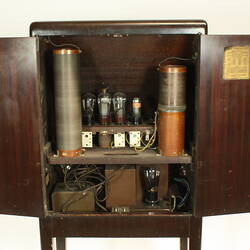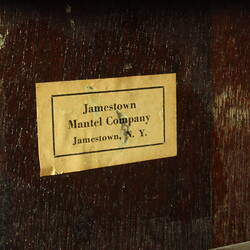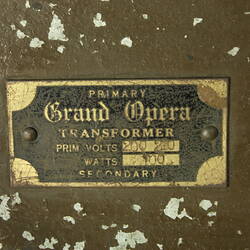Summary
The theremin, named after its inventor Leon Theremin, was an early electronic musical instrument with two antennas that controlled the pitch and amplitude of the sound it produced by variation of capacitance to the operator's hands.
The instrument does not have its own loudspeaker, two sockets are provided for connection to an external one. The recommended speaker was the RCA model 106, an electrodynamic moving coil speaker in a console cabinet with a tapestry cloth covering on 3 sides.
The pitch control worked by beating two oscillators together, one fixed and the other arranged so that its frequency was dependent on the capacitance between the vertical electrode and the player's right hand. The difference (beat) frequency could be varied from zero to a few kilohertz depending on how close the player's hand was to the vertical electrode. The volume control antenna on the side and played by the left hand works by having a fixed frequency oscillator loosely coupled to a secondary winding whose resonant frequency is dependent on the capacitance of the side electrode to ground. The current in a winding closely coupled to the secondary lights the filament of a directly heated triode connected as a diode through which the plate current for the first audio amplifier is fed. De-tuning the secondary winding reduces the filament voltage and hence the current supply to the amplifier. When the player's hand is close to the volume antenna, the output will go to zero. An unusual feature of this instrument is that the spaces between notes and rests must be 'played'.
Physical Description
Sloping front lacquered wooden cabinet mounted on four thin legs. It has a hinged rest at the bottom of the sloping panel for printed music and a pair of doors at the back for access to the works. The two door knobs are missing. A vertical plated metal rod plugs into a holder on the right hand side of the instrument and a 'P' shaped loop plugs into a pair of receptacles on the left hand side. Inside the cabinet there are two metal chassis, one on the bottom of the cabinet and one on a shelf above it and two large coils, one at each side. The lower one is the power supply, the upper one contains the oscillators, the beat frequency generator and the audio amplifier. There is also a step-down transformer adjacent to the power supply chassis on the bottom to allow operation from 240 V mains. The bottoms of both doors are fitted with an 'L' shaped fitting on the inner side furthest from the hinge. These engage with a pair of safety switches intended to turn off the power when either door is open. The two switches that should be on the right hand side of the front panel have been removed also the pilot light between the pitch and volume controls has been removed.
More Information
-
Collecting Areas
-
Acquisition Information
Donation from Mrs Jeffery, 1977
-
Manufactured For
Radio Victor Corporation of America, United States of America, 1929-1930
-
Manufacturer
-
Inscriptions
On front panel: Volume Pitch Inside cabinet, lower left side (viewed from the back): Jamestown / Mantel Company / Jamestown NY Stamped into left hand end of top chassis: 200052 (Serial number) Stencilled on top of upper chassis: UY227 UY227 UY224 UY227 UX120 UX171A UX171A Inside right hand door, near top: RCA THEREMIN / MODEL AR-1264 / INPUT VOLTS 105-125 CYCLES 50-60 / MAX INPUT WATTS 60 / CAUTION! BEFORE INSTALLING OR OPERATING / READ INSTRUCTIONS / (Patent numbers & licence notice) / RADIO VICTOR CORPORATION OF AMERICA / NEW YORK NY U.S.A. / NP 48014 Stencilled on bottom chassis: UX280 110V 120V On step-down transformer: PRIMARY / GRAND OPERA / TRANSFORMER / PRIM VOLTS 200 - 220 / WATTS 100 / SECONDARY On bottom edge of right hand door (viewed from back): 417 (cabinet number)
-
Classification
Music & musical instruments, Instruments - electronic, Experimental
-
Category
-
Discipline
-
Type of item
-
Overall Dimensions
480 mm (Width), 320 mm (Depth), 1200 mm (Height)
Without electrodes
-
Overall Dimensions
31 cm (Length), 82 cm (Width), 163 cm (Height)
Measurement From Conservation. INDICATE DEEP height:1= depth 31cm Measuring Method: measured with both antennae attached.
-
References
-
Keywords
Electronic Musical Instruments, Musical Synthesizers, Theremins
